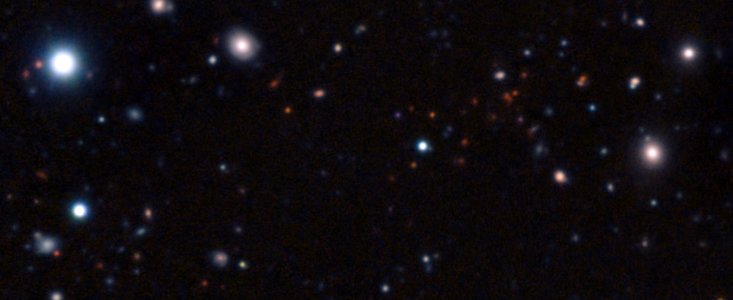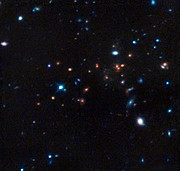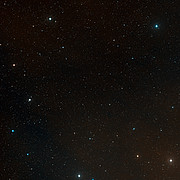Persbericht
De verste volgroeide cluster van sterrenstelsels
Jong, maar verrassend volwassen
9 maart 2011
Astronomen hebben een armada aan telescopen op de grond en in de ruimte, waaronder de Very Large Telescope van de ESO-sterrenwacht op de Paranal in Chili, gebruikt om de afstand van de verst bekende volwassen cluster van sterrenstelsels te meten. Hoewel deze cluster gezien wordt op een moment dat het heelal minder dan een kwart van zijn huidige leeftijd had, lijkt de verre cluster verrassend veel op zijn huidige soortgenoten.
"We hebben de afstand gemeten tot de verste volwassen cluster van sterrenstelsels die ooit gevonden is", zegt Raphael Gobat (CEA, Parijs) – eerste auteur van het onderzoek waarbij waarnemingen met ESO’s Very Large Telescope (VLT) zijn gebruikt. "Het verrassende is dat als we beter naar deze cluster kijken, hij er helemaal niet jong uitziet: veel van de sterrenstelsels zijn tot rust gekomen en lijken niet op de stervormende sterrenstelsels die gebruikelijk zijn in het jonge heelal."
Clusters van sterrenstelsels zijn de grootste structuren in het heelal die door de zwaartekracht bijeengehouden worden. Astronomen gaan ervan uit dat clusters in de loop van de tijd groter worden, en dat zware clusters dus schaars moeten zijn in het vroege heelal. Hoewel nog verder weg gelegen clusters zijn waargenomen, lijken dat jonge clusters te zijn waarvan het ontstaansproces nog niet voltooid is.
Het internationale team van astronomen gebruikte de krachtige instrumenten VIMOS en FORS2 van ESO’s VLT om de afstanden te meten van enkele vlekjes die deel uitmaken van een merkwaardige groepering van zeer zwakke, rode objecten die met de Spitzer-ruimtetelescoop zijn ontdekt. Deze groep, die CL J1449+0856 heet [1], heeft alle kenmerken van een zeer verre cluster van sterrenstelsels [2]. Uit de resultaten blijkt dat we hier inderdaad te maken hebben met een cluster zoals die was toen het heelal ongeveer drie miljard jaar oud was – minder dan een kwart van zijn huidige leeftijd [3].
Toen het team eenmaal de afstand tot dit zeer zeldzame object kende, richtten de astronomen de Hubble-ruimtelescoop van NASA/ESA en telescopen op de grond, waaronder de VLT, op de afzonderlijke sterrenstelsels. Dat nauwkeurige vervolgonderzoek leverde aanwijzingen op dat deze stelsels geen nieuwe sterren vormen, maar zijn opgebouwd uit sterren die al bijna een miljard jaar oud zijn. Dit maakt de cluster tot een volgroeid object dat qua massa vergelijkbaar is met de Virgo-cluster – de meest nabije rijke cluster van sterrenstelsels in onze omgeving.
Dat CL J1449+0856 volwassen is, blijkt ook uit waarnemingen (met de ESA-satelliet XMM-Newton) van de röntgenstraling die de cluster uitzendt. Deze röntgenstraling moet afkomstig zijn van een zeer hete wolk van ijl gas dat de ruimte tussen de sterrenstelsels vult, en het meest geconcentreerd is in het centrum van de cluster. Ook dat wijst erop dat het gaat om een volwassen cluster van sterrenstelsels die stevig bijeengehouden wordt door zijn eigen zwaartekracht. Erg jonge clusters hebben namelijk nog niet de tijd gehad om heet gas op deze manier vast te houden.
Gobat concludeert dan ook: "Deze nieuwe resultaten bevestigen het idee dat er al volwassen clusters bestonden toen het heelal minder dan een kwart van zijn huidige leeftijd had. Volgens de huidige inzichten moeten zulke clusters heel schaars zijn, en heb je dus veel geluk nodig om er eentje te vinden. Maar als uit verdere waarnemingen blijkt dat er veel meer van deze clusters zijn, zullen we onze ideeën over het vroege heelal moeten bijstellen."
Noten
[1] De vreemde naam verwijst naar de hemelpositie van het object.
[2] Dat de sterrenstelsels op de foto rood lijken, komt deels doordat ze vermoedelijk vooral uit koele, rode sterren bestaan. Daar komt nog bij dat de uitdijing van het heelal ervoor heeft gezorgd dat de golflengte van het licht dat deze verre stelsels hebben uitgezonden is toegenomen, waardoor het grotendeels in de vorm van infraroodstraling op aarde aankomt.
[3] De astronomen maten de afstand tot de cluster door zijn licht met een spectrograaf in zijn samenstellende kleuren te ontleden. Vervolgens vergeleken zij dit spectrum met dat van een soortgelijk object in het nabije heelal. Dit stelde hen in staat om de roodverschuiving van de verre sterrenstelsels te meten – een maat die aangeeft hoeveel groter het heelal is geworden sinds het licht door de stelsels werd uitgezonden. Ze vonden een roodverschuiving van 2,07, wat betekent dat de cluster wordt gezien zoals hij ongeveer drie miljard jaar na de oerknal was.
Meer informatie
Dit onderzoek wordt gepresenteerd in het artikel ‘A mature cluster with X-ray emission at z = 2.07’, door R. Gobat et al., in het tijdschrift Astronomy & Astrophysics.
Het team bestaat uit R. Gobat (Laboratoire AIM-Paris-Saclay, Frankrijk), E. Daddi (AIM-Paris), M. Onodera (ETH Zürich, Zwitserland), A. Finoguenov (Max-Planck-Institut für extraterrestrische Physik, Garching, Duitsland), A. Renzini (INAF–Osservatorio Astronomico di Padova, Italië), N. Arimoto (National Astronomical Observatory of Japan), R. Bouwens (Lick Observatory, Santa Cruz, VS), M. Brusa (ETH), R.-R. Chary (California Institute of Technology, VS), A. Cimatti (Università di Bologna, Italië), M. Dickinson (NOAO, Tucson, VS), X. Kong (University of Science and Technology of China) en M.Mignoli (INAF – Osservatorio Astronomico di Bologna, Italië).
ESO, de Europese Zuidelijke Sterrenwacht, is de belangrijkste intergouvernementele sterrenkundeorganisatie in Europa, en het meest productieve astronomische observatorium ter wereld. ESO wordt ondersteund door 15 landen: België, Brazilië, Denemarken, Duitsland, Finland, Frankrijk, Italië, Nederland, Oostenrijk, Portugal, Spanje, Tsjechië, het Verenigd Koninkrijk, Zweden en Zwitserland. ESO voert een ambitieus programma uit, gericht op het ontwerp, de bouw en het beheer van krachtige grondobservatoria die astronomen in staat stellen om belangrijke wetenschappelijke ontdekkingen te doen. ESO speelt ook een leidende rol bij het bevorderen en organiseren van samenwerking op sterrenkundig gebied. ESO beheert drie waarnemingslocaties van wereldklasse in Chili: La Silla, Paranal en Chajnantor. Op Paranal staat ESO’s Very Large Telescope (VLT), de meest geavanceerde optische sterrenwacht ter wereld. Ook is ESO de Europese partner van de revolutionaire telescoop ALMA, het grootste sterrenkundige project van dit moment. Daarnaast bereidt ESO momenteel de bouw voor van de 42-meter Europese Extremely Large optische/nabij-infrarood Telescoop (E-ELT), die ‘het grootste oog op de hemel’ ter wereld zal worden.
Links
Contact
Dr Raphael Gobat
Laboratoire AIM-Paris-Saclay, CEA/DSM-CNRS–Université Paris Diderot
Gif-sur-Yvette, France
Tel: +33 1 69 08 60 01
E-mail: raphael.gobat@cea.fr
Richard Hook
ESO, La Silla, Paranal, E-ELT and Survey Telescopes Public Information Officer
Garching bei München, Germany
Tel: +49 89 3200 6655
E-mail: rhook@eso.org
Rodrigo Alvarez (press contact België)
ESO Science Outreach Network
en Planetarium, Royal Observatory of Belgium
Tel: +32-2-474 70 50
E-mail: eson-belgië@eso.org
Over dit bericht
| Persberichten nr.: | eso1108nl-be |
| Naam: | CL J1449+0856 |
| Type: | Milky Way : Galaxy : Grouping : Cluster |
| Facility: | Very Large Telescope |
| Instruments: | FORS2, VIMOS |
| Science data: | 2011A&A...526A.133G |
Our use of Cookies
We use cookies that are essential for accessing our websites and using our services. We also use cookies to analyse, measure and improve our websites’ performance, to enable content sharing via social media and to display media content hosted on third-party platforms.
ESO Cookies Policy
The European Organisation for Astronomical Research in the Southern Hemisphere (ESO) is the pre-eminent intergovernmental science and technology organisation in astronomy. It carries out an ambitious programme focused on the design, construction and operation of powerful ground-based observing facilities for astronomy.
This Cookies Policy is intended to provide clarity by outlining the cookies used on the ESO public websites, their functions, the options you have for controlling them, and the ways you can contact us for additional details.
What are cookies?
Cookies are small pieces of data stored on your device by websites you visit. They serve various purposes, such as remembering login credentials and preferences and enhance your browsing experience.
Categories of cookies we use
Essential cookies (always active): These cookies are strictly necessary for the proper functioning of our website. Without these cookies, the website cannot operate correctly, and certain services, such as logging in or accessing secure areas, may not be available; because they are essential for the website’s operation, they cannot be disabled.
Functional Cookies: These cookies enhance your browsing experience by enabling additional features and personalization, such as remembering your preferences and settings. While not strictly necessary for the website to function, they improve usability and convenience; these cookies are only placed if you provide your consent.
Analytics cookies: These cookies collect information about how visitors interact with our website, such as which pages are visited most often and how users navigate the site. This data helps us improve website performance, optimize content, and enhance the user experience; these cookies are only placed if you provide your consent. We use the following analytics cookies.
Matomo Cookies:
This website uses Matomo (formerly Piwik), an open source software which enables the statistical analysis of website visits. Matomo uses cookies (text files) which are saved on your computer and which allow us to analyze how you use our website. The website user information generated by the cookies will only be saved on the servers of our IT Department. We use this information to analyze www.eso.org visits and to prepare reports on website activities. These data will not be disclosed to third parties.
On behalf of ESO, Matomo will use this information for the purpose of evaluating your use of the website, compiling reports on website activity and providing other services relating to website activity and internet usage.
Matomo cookies settings:
Additional Third-party cookies on ESO websites: some of our pages display content from external providers, e.g. YouTube.
Such third-party services are outside of ESO control and may, at any time, change their terms of service, use of cookies, etc.
YouTube: Some videos on the ESO website are embedded from ESO’s official YouTube channel. We have enabled YouTube’s privacy-enhanced mode, meaning that no cookies are set unless the user actively clicks on the video to play it. Additionally, in this mode, YouTube does not store any personally identifiable cookie data for embedded video playbacks. For more details, please refer to YouTube’s embedding videos information page.
Cookies can also be classified based on the following elements.
Regarding the domain, there are:
- First-party cookies, set by the website you are currently visiting. They are stored by the same domain that you are browsing and are used to enhance your experience on that site;
- Third-party cookies, set by a domain other than the one you are currently visiting.
As for their duration, cookies can be:
- Browser-session cookies, which are deleted when the user closes the browser;
- Stored cookies, which stay on the user's device for a predetermined period of time.
How to manage cookies
Cookie settings: You can modify your cookie choices for the ESO webpages at any time by clicking on the link Cookie settings at the bottom of any page.
In your browser: If you wish to delete cookies or instruct your browser to delete or block cookies by default, please visit the help pages of your browser:
Please be aware that if you delete or decline cookies, certain functionalities of our website may be not be available and your browsing experience may be affected.
You can set most browsers to prevent any cookies being placed on your device, but you may then have to manually adjust some preferences every time you visit a site/page. And some services and functionalities may not work properly at all (e.g. profile logging-in, shop check out).
Updates to the ESO Cookies Policy
The ESO Cookies Policy may be subject to future updates, which will be made available on this page.
Additional information
For any queries related to cookies, please contact: pdprATesoDOTorg.
As ESO public webpages are managed by our Department of Communication, your questions will be dealt with the support of the said Department.




